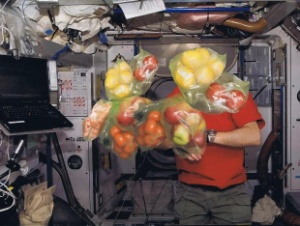Nov 11 2010
Evert Fresh “Original” Green BagsTM have journeyed to the South Pole and to space, most recently to the International Space Station in May.
Fresh fruits and vegetables are like gold for astronauts and Antarctica explorers and, with rising food costs and a sputtering economy, at home for Thanksgiving.
 Astronauts at the International Space Station in May preserved their fruit and vegetables with Evert Fresh "Original" Green Bags. Evert Fresh "Original" Green Bags help preserve fresh produce under the most demanding conditions from Antarctica to the International Space Station. This Thanksgiving, save money by extending the shelf life of holiday produce. Evert Fresh "Original" Green Bags(TM) are FDA approved and Made in the USA.
Astronauts at the International Space Station in May preserved their fruit and vegetables with Evert Fresh "Original" Green Bags. Evert Fresh "Original" Green Bags help preserve fresh produce under the most demanding conditions from Antarctica to the International Space Station. This Thanksgiving, save money by extending the shelf life of holiday produce. Evert Fresh "Original" Green Bags(TM) are FDA approved and Made in the USA.
Based on thousands of years of successful housing of produce in Japanese oya caves, Green Bags were created for U.S. consumers in 1988 by Texas rancher Lynn Everts. Oya interrupts the natural ripening process by adsorbing ethylene gas emitted by fruits and vegetables. Researchers figured out how to impregnate oya into low-density food-grade material and Everts, a serial entrepreneur, saw opportunity.
“I knew how much produce I threw away and thought everybody at some time or another would have a use for a bag like this. Two heads of lettuce picked at the same time and delivered to the same place the same way – the one in the Green Bag will have its shelf life doubled.”
One Bad Apple …
There’s a reason they say one bad apple spoils the whole bunch: the riper the fruit, the more ethylene, which affects all the fruit around it. Green Bags are better for:
- The environment – Green Bags are reusable and recyclable.
- The household economy – Green Bags extend the shelf life of fruits and vegetables so they last longer and save money.
- The waistline – Keeping produce fresher longer with Green Bags allows families to eat more nutrient-rich, lower-calorie fruits and vegetables.
- Peace of mind – Green Bags are FDA approved and made in the USA.